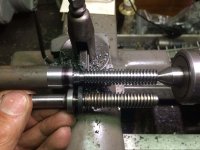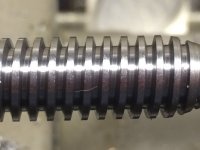Good advice. I did switch to HSS at the end but found the finish wasnt a whole lot better; so I went back to the carbide.Very good.
Why not a 4 jaw chuck and the spider only on the outboard?
"Muzzle done. Onto the breech end. First I chucked it up in the spider to cut the OD to match the factory Ghost barrel.
The surface finish was just OK. My cheap chinese carbide inserts are spec'd more for aluminum, so I used a green scotch-bright pad to cover up the evidence.
I think another factor was the "stick out." The barrel was held in a "spyder" in a chuck and still had a few inches of stick out. The super light cuts necessary generally arent well suited for carbide tooling."
Part is not hanging out too far for light cuts at all. Just stop and invest some time in making HSS tool bits. The best investment a hobbiest can make. Few ever do. Then you'll start getting a decent finish. Not to brag or cut up. Trying to help you. And here is proof. And why I never use carbide.
Examples. None of these steel parts were ever polished. Mostly all made from scrap steel.
View attachment 436798View attachment 436789View attachment 436790View attachment 436791View attachment 436794View attachment 436796
Above. The bolt above was single pointed and then case hardened. Replaced a missing carriage lock bolt on a South Bend lathe. Not hardened yet.
Below. A small 60 degree HSS bit for making little screws. Threads up to a shoulder. I make a lot of small screws. Gotta focus and time the half nuts right. I don't thread in back gear, it's too slow. These are proprietary threads and there are no dies. For prewar BSA. I dial in DOC with the compound set over at 29.5 degrees for a reason and you probably already know why.
View attachment 436845
When I learned to operate a lathe HSS was what we were taught to use. A few bits and an Elk Tool tool holder
View attachment 436867
I hope you find this useful
The reason for the spider with 2 sets of bolts is to bring the barrel into concentricity along two points. With a 4 jaw, the bore can be dialed in on one point. For example, think about when a rod is chucked up. Sometimes its necessary to tap the end to eliminate wobble even though the jaws may be centered properly.
Nice work your doing!
Upvote 0

